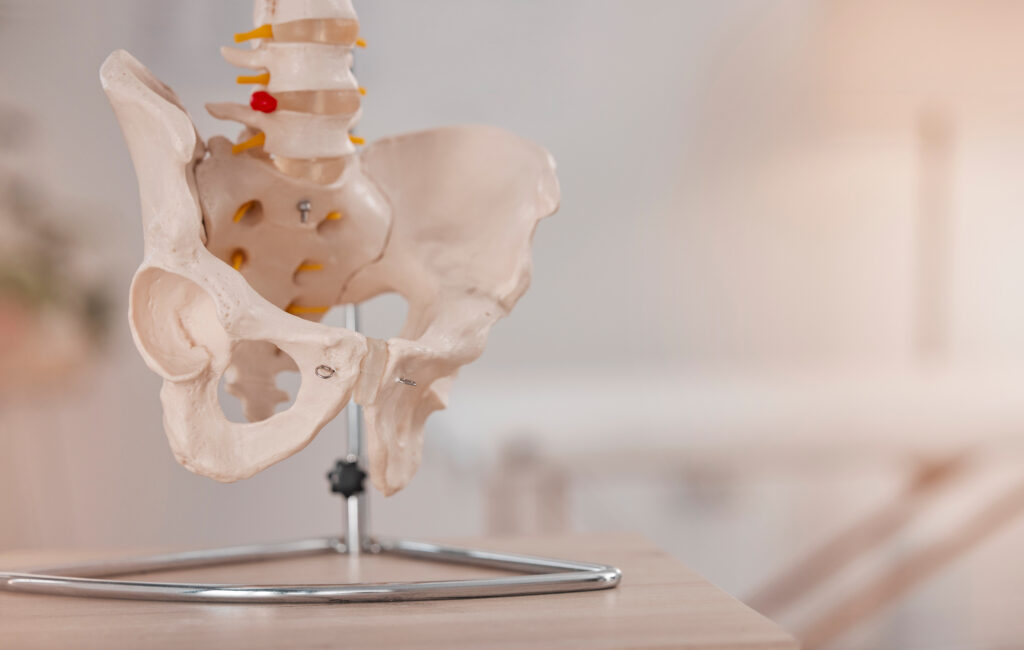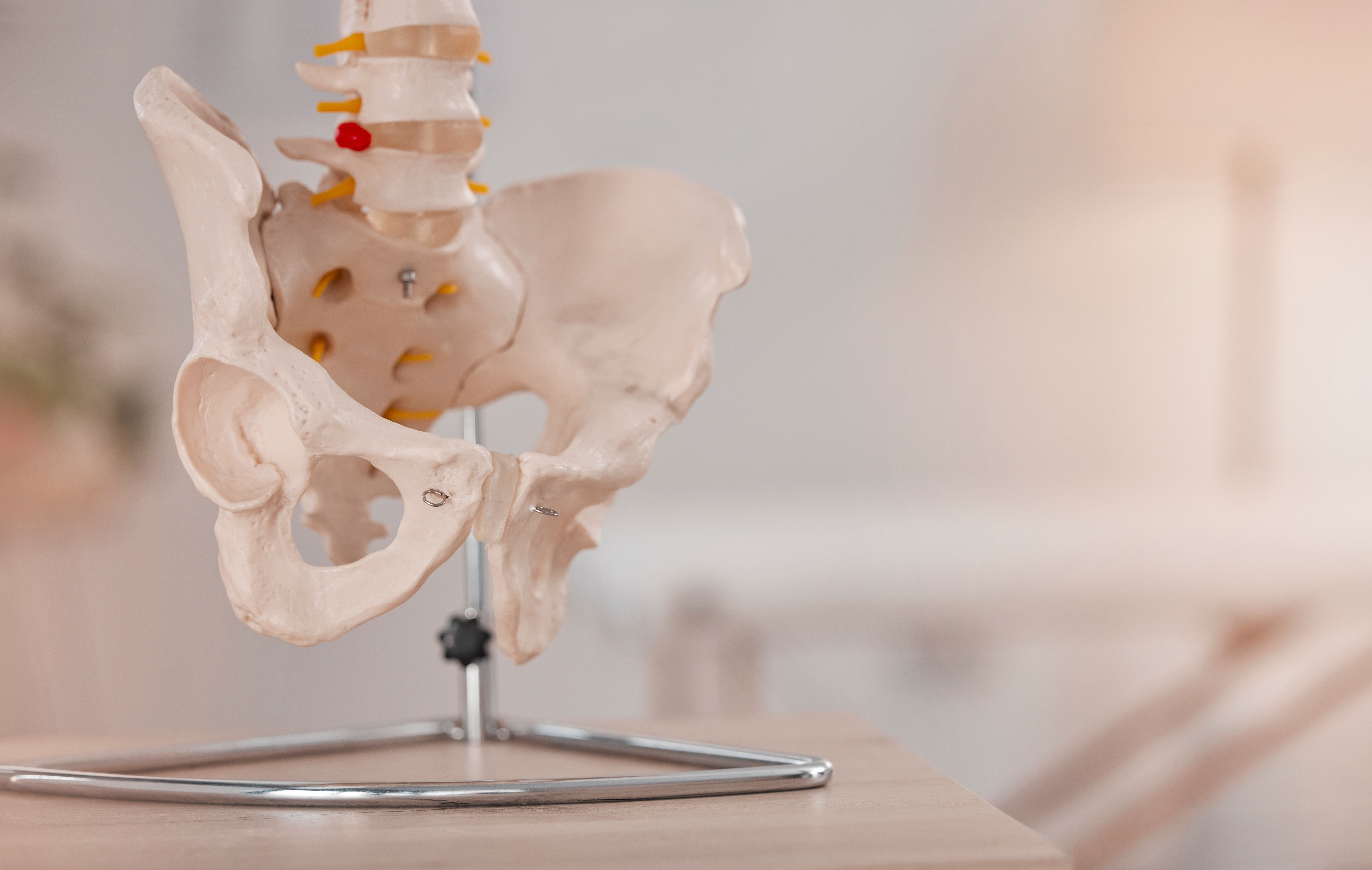The pelvic floor is a critical yet often overlooked component of the body. Problems with this group of muscles can cause pain and discomfort in both men and women. Hina explores what the pelvic floor is, how it functions, why can the pelvic floor cause pain in men and women, and potential solutions for managing pelvic floor dysfunction.
What is the Pelvic Floor?
The pelvic floor is a group of muscles located within the pelvic cavity. To understand its structure, imagine a model of the pelvis. The pelvis consists of two pelvic bones, which connect at the front to form the pubic bone and at the back to the sacrum—a bone that resembles a cobra’s head. The sacrum ends in the tailbone, and the hips extend from the pelvic sockets, connecting to the spine above the sacrum. This interconnected network forms the foundation of the lower body.
Inside this structure lies the pelvic floor, composed of over 16 muscles that span from the pubic bone to the tailbone and extend outward to the sit bones. These muscles are not a single entity but a complex group that supports vital functions. Though there are structural differences between men and women, such as the presence of a penis or vagina, the pelvic floor’s role and composition are remarkably similar in both sexes.
How Does the Pelvic Floor Function?
The pelvic floor muscles serve multiple purposes:
- Support: They support the organs in the pelvic region, including the bladder, rectum, and, in women, the uterus.
- Control: These muscles help regulate bowel and bladder movements.
- Stability: They contribute to the stability of the spine, pelvis, and hips.
- Sexual Function: The pelvic floor plays a role in sexual sensation and function in both men and women.
When functioning correctly, the pelvic floor muscles contract and relax as needed. However, dysfunction can occur when these muscles become either too tight or too weak.
Causes of Pelvic Floor Dysfunction
Pelvic floor dysfunction is often linked to tightness in the muscles. Various factors can contribute to this tightness, including:
- Injuries: Previous injuries to the hip, tailbone, pubic bone, or lower back can lead to muscle tightness.
- Pregnancy and Childbirth: Women may experience pelvic floor issues after giving birth.
- Stress: Chronic stress can cause muscle tension throughout the body, including the pelvic floor.
- Nerve Compression: Tight muscles may compress nerves, such as the pudendal nerve, leading to pain and numbness.
- Prolonged Sitting: Sitting for extended periods can strain the pelvic muscles and exacerbate tightness.
Symptoms of Pelvic Floor Dysfunction
Pelvic floor dysfunction manifests differently in men and women, though many symptoms overlap:
- In Men:
- Rectal, scrotal, or penile pain
- A sense of fullness in the prostate or rectum
- Urinary hesitation or retention
- Numbness or shooting pain in the pelvic region
- Constipation or irritable bowel syndrome (IBS)
- In Women:
- Vaginal pain or pain during intercourse
- Urinary frequency, urgency, or bladder pain
- Prolapse of pelvic organs
- Constipation or IBS
Both sexes may experience conditions such as pudendal neuralgia, which is caused by nerve compression in the pelvic area, and interstitial cystitis, a chronic bladder condition.

Misdiagnoses and Common Challenges
One of the challenges of diagnosing pelvic floor dysfunction is that its symptoms often mimic other conditions. For instance, many men and women visit colorectal specialists, believing hemorrhoids are causing their pain, only to find out the pelvic floor muscles are the true culprits. Similarly, conditions like interstitial cystitis or chronic urinary tract issues may mask the underlying problem.
Treatment for Pelvic Floor Dysfunction
Effective treatment of pelvic floor dysfunction requires addressing the underlying muscle tightness and restoring balance to the affected areas. Here are key steps involved in treatment:
- Muscle Relaxation: Techniques to relax the pelvic floor muscles are essential. These may include physical therapy interventions, such as myofascial release or trigger point therapy.
- Internal and External Therapy: Skilled practitioners may work on the muscles both internally and externally to release tension and improve function.
- Joint Alignment: Ensuring proper alignment of the spine, pelvis, hips, and tailbone is crucial, as imbalances can exacerbate muscle tightness.
- Stress Management: Addressing stress through mindfulness techniques, relaxation exercises, or therapy can help prevent chronic tension.
- Specialized Care: Seeing a specialist in pelvic health, such as a physical therapist with expertise in the spine, pelvis, and hips, can make a significant difference. These professionals use tailored evaluation and treatment plans to address the unique needs of each patient.
Why Many People Struggle to Find Relief
Many individuals with pelvic floor dysfunction feel frustrated after consulting multiple healthcare providers without finding answers. Misdiagnoses or incomplete treatment plans can leave patients without relief. Common scenarios include:
- Seeing a chiropractor or general physical therapist who may not specialize in pelvic health
- Receiving treatments that focus solely on symptoms rather than addressing the root cause
Why Does the Pelvic Floor Cause Pain in Men and Women? – Conclusion
The pelvic floor is a complex and vital part of the human body, and dysfunction in this area can lead to significant pain and discomfort. Both men and women can suffer from pelvic floor issues, often experiencing a wide range of symptoms. Proper diagnosis and treatment, often involving highly specialized care, are crucial for addressing these challenges. If you’ve been struggling with unresolved pain or other pelvic symptoms, seeking help from a qualified pelvic health professional may provide the answers and relief you need.
Also Read: What is Vaginismus and How Can it Be Treated?
I’m Hina Sheth. I have been treating complex orthopedics, sports and pelvic floor physical problems for over 25 years with amazing results. Now I want to bring my knowledge to the global community so I can spread my knowledge to you.
Our bodies are complex systems of 600 muscles and organs intertwined in a fascial system that all work together. Imbalances in this system such as trigger points, visceral and myofascial restrictions can lead to joint, pelvic, and organ issues.
Factors like nutrition, exercise, sleep, and stress play a crucial role. Unfortunately, our current healthcare model does not look at our bodies as a whole and oftentimes compartmentalize musculoskeletal injuries and dysfunctions.
At Rebalance, our goal is to holistically treat this complex system to restore harmony in the body. By addressing these imbalances, we help clients improve their overall health and well-being. Our vision is to empower individuals to create a healthier lifestyle for themselves.






